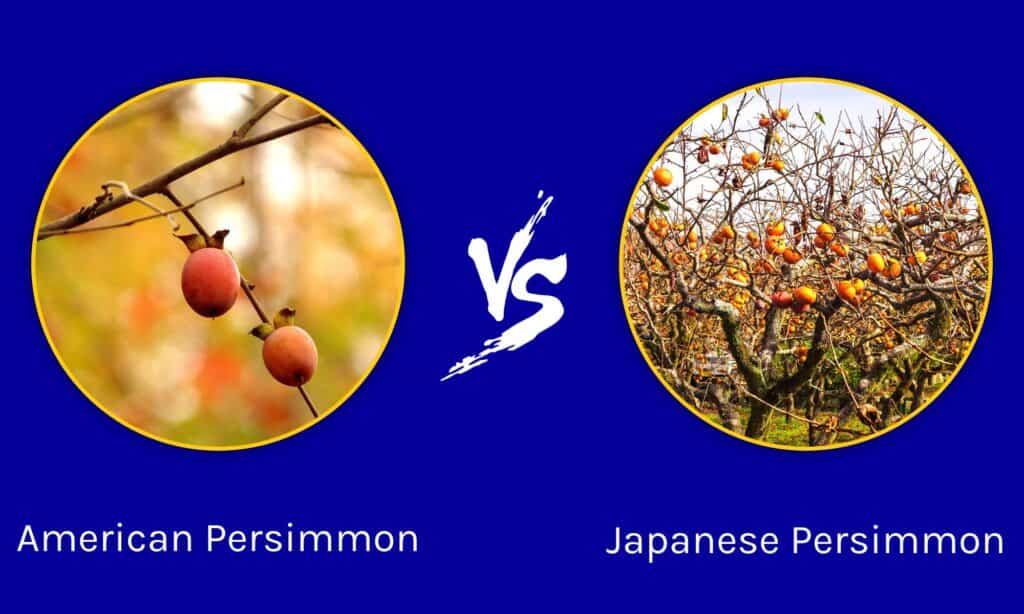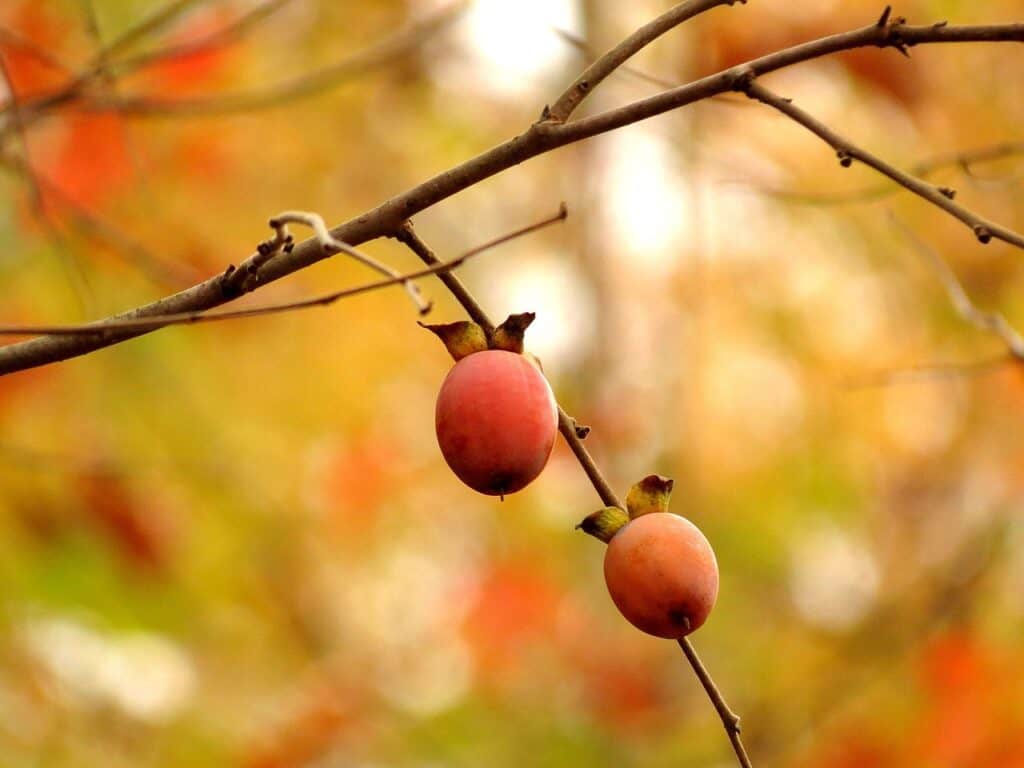Persimmons are delicious and edible fruit. They grow on multiple tree species within the broader Diospyros family. But despite their common name, each persimmon is as unique as the species of tree it grows on.
This article explores two distinct species — the American persimmon (Diospyros virginiana) and the Japanese persimmon (Diospyros kaki). You will discover how these two species are similar, along with how they stand out.

American Persimmon vs. Japanese Persimmon: Comparison
| American Persimmon | Japanese Persimmon | |
|---|---|---|
| Scientific Classification | Diospyros virginiana | Diospyros kaki |
| Common Name(s) | American Persimmon; Common Persimmon; Date Plum; Possumwood | Asian Persimmon; Japanese Persimmon; Kaki; Oriental Persimmon |
| Origin | Central and Eastern United States | Eastern Asia and India |
| Size | Large, woody deciduous tree. Can reach heights of 30-80 feet. And grow up to 20-35 feet wide. | Round top, slightly willowy appearance. Grows 15 to 60 feet high and no more than 15 to 20 feet wide. |
| Fruit | Develop in the fall. They are extremely sweet and beloved by birds and mammals. And the base forms an easily recognizable beak. | This persimmon varietal is parthenocarpic, so it has the ability to grow seedless fruit without the help of pollinators. The fruit stays on the tree well into fall. It is classified as an astrigent persimmon. |
| Bark | Super thick, gray bark that forms a checkerboard appearance. | Deep fissures that create the appearance of rectangles or squares. |
| Flowers | They bloom in the early spring into the summer. | Blooms arrive early to avoid the chance of frost. |
| Growing Requirements | The trees prefer sandy, well-draining, and moist soil. Extremely tolerant to adverse conditions. Susceptible to leaf spot. | Not tolerant of cold weather. Anywhere that gets below 10°F is a no go. They love well-draining, loamy soil that has a pH of 6.0 to 6.5. Need full sun. No problems with diseases or insects. |
| Fun Facts | Derives its name from “putchamin,” which is a word from the Algonquin tribe. | The name Diospyros comes from two Greek words and translates to “wheat of Zeus” or “divine fruit.” |
Key Differences Between the American Persimmon and the Japanese Persimmon
Both the American Persimmon (Diospyros virginiana) and the Japanese Persimmon (Diospyros kaki) belong to the Ebenaceae (ebony) family. Many species of tree in this family grow the prized persimmons. However, other species are highly valued for their beautiful ebony wood.
While the American and Japanese persimmon trees share some common traits, they also have striking differences. Those differences are primarily in their origin, size, fruit, and growing requirements. Below, we dive into each of these categories more in-depth.
American Persimmon vs. Japanese Persimmon: Origin
The Japanese persimmon (Diospyros kaki) is native to Eastern Asia and India. That is why some of its other common names include Oriental persimmon and Asian persimmon. This beautiful tree got introduced to the United States in 1856.
The American persimmon (Diospyros virginiana) gets its name due to its origin. This species is native to the central and eastern portions of the United States.

Japanese persimmon is native to India and Eastern Asia.
©iStock.com/Wiphop Sathawirawong
American Persimmon vs. Japanese Persimmon: Size
The American persimmon is significantly larger than its cousin. They can reach heights of 30 to 60 feet and may grow up to 35 feet high. You will occasionally see smaller American persimmon trees. However, that only occurs when the tree has grown up in poor-quality soil. It will survive and bear fruit in these cases but won’t grow much taller than the Japanese persimmon.
The Japanese persimmon typically grows between 15 and 60 feet tall, though rarely more than 20 feet wide. It can also get pruned down to create more of a hedge-type barrier, thanks to its willowy nature.
American Persimmon vs. Japanese Persimmon: Fruit
American persimmon trees produce exceptionally sweet fruit. It is a delicacy for birds, mammals, and humans.
But the Japanese persimmon fruit is typically quite astringent. That is due to the presence of organic compounds like tannins. For this reason, they must be fully ripe and soft before being eaten. Cultivators of Japanese persimmons can occasionally avoid this astringency. To accomplish this, they introduce pollinators.
American Persimmon vs. Japanese Persimmon: Growing Requirements
The American persimmon will grow just about anywhere, making it a highly versatile and fantastic addition to any yard, garden, or landscaped area. They do prefer soil that is sandy, moist, and well-draining. However, they are extremely tolerant to heat, drought, poor-quality soil, high wind, and urban environments.
But, if the American persimmon lives in poor areas, it will be shorter and more stout in stature. They will take on a smaller, shrub-like appearance and only reach roughly 15 feet high when grown under less ideal conditions.
The American persimmon also requires a lot of patience to grow. It takes 4-9 years for its first fruits to develop after getting propagated by seeds. They will bear fruit sooner when grafted, though not by much.
In contrast, the Japanese persimmon may bear fruit in slightly less time. You can typically expect fruit to appear within 4-6 years after planting. And like their cousin, Japanese persimmons love well-draining soil. However, they prefer loamy rather than sandy soil. And the ideal pH level for these trees ranges from 6.0 to 6.5.
Additionally, Japanese persimmons are more forgiving and will thrive in many environments. They are smaller and can easily get pruned back into hedges. You can easily add them to an edible garden or on your lawn.

American persimmon is highly versatile.
©Katja Schulz from Washington, D. C., USA / CC BY 2.0 – License
The photo featured at the top of this post is © Katja Schulz from Washington, D. C., USA / CC BY 2.0 – License / Original
FAQs (Frequently Asked Questions)
Are Japanese persimmons or American persimmons sweeter?
Japanese persimmons will typically not be as sweet as their cousins. The fruit is often grown without pollination. It results in a marked astringency. And that astringency can only be reduced when the fruit gets fully softened.
The American persimmon is known for its exceptionally sweet flavor. However, it does not get cultivated as often as the Japanese persimmon.
Are either Japanese or American persimmons seedless?
The Japanese persimmon can grow fruit without seeds.
The American persimmon requires pollination for its fruit to grow. And fruit that gets pollinated develops seeds.
Where can I grow Japanese or American persimmons?
You can add either beautiful persimmon tree to nearly any environment. The Japanese persimmon is smaller in stature and can easily fit in a lawn or edible garden. And while the American persimmon is quite a bit larger, it grows to a much smaller size when planted in poor soil.
Both prefer partial shade, particularly in the heat of the afternoon. And neither likes the extreme cold. So as long as you are in USDA Hardiness Zones 4-9, your Japanese or American persimmon will survive.
How tall do the Japanese and American persimmons grow?
When provided with quality soil, the American persimmon can grow to an enormous stature. It can grow as tall as 30 to 80 feet and span up to 35 feet wide.
Japanese persimmons are slightly smaller. They reach from 15 to 60 feet tall and rarely span more than 15 to 20 feet wide.
Thank you for reading! Have some feedback for us? Contact the AZ Animals editorial team.






